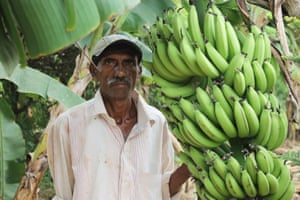Camels pulling wooden carts loaded with coconuts plod down the main road amid speeding motorcycles, buses, rickshaws and cars. Farmers sit atop slow-moving oxcarts loaded with grasses and other cattle feed. In this region of central Gujarat, India, it appears that rural life has not changed for decades.
But drive down a dirt road outside the village of Thamna, about an hour north of Anand, and the 21st century comes into view. Solar panels drive a water pump that irrigates the fields of farmer Raman Bhai Parmar, 65, who grows bananas, rice and wheat on seven acres of land.

Parmar’s solar energy pump is one of the technologies being promoted by a new project designed to help rural Indians adapt to climate change. The project, run by the international NGO, the Consultative Group for International Agriculture Research programme on climate change, agriculture and food security (CCAFS), aims to create 1,000 so-called climate smart villages across six Indian states including Haryana, Punjab and Gujarat.
Haryana and Punjab are known as the grain basket states of India, producing the majority of the country’s staple wheat and basmati rice for export to the Middle East and European markets. The pumping of groundwater for irrigation over the past thirty years has led to a spike in productivity and increased food security.
However, the region faces increases in temperature up to 5C by 2080 and wheat is particularly vulnerable to heat stress. A recent study by the Indian Agricultural Research Institute indicates that climate change may reduce wheat yields in India between 6% and 23% by 2050. Environmental problems such as depleting groundwater and variable rains – delayed monsoons and intense rainfall – limit yields. Indian farmers also typically use almost twice the amount of fertiliser needed, damaging soil, contaminating groundwater and adding to greenhouse gas emissions.
Read the full article originally published in The Guardian.
